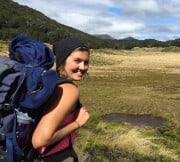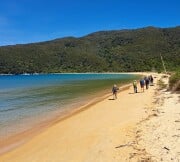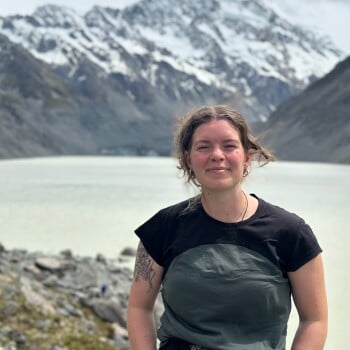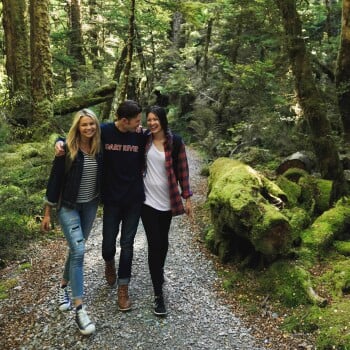- About Us
-
Trips
-
 Kiwi-Style Hiking
Kiwi-Style Hiking
-
 Great Walks
Great Walks
-
 Hiking Tours
Hiking Tours
-
Alpine Hikes
-
Custom Groups
- Huayhuash Trek
- Family Northern Explorer
- Family Southern Explorer
- Lake Waikaremoana Hike
- Women's Custom Tours
- Women's Southern Wilderness
- Coast, Canyons and Mountains
- Coastal Wanderer Custom Tour
- Don't Cross the Ladies
- Secret South Custom Tour
- Tekapo Hike
- West Coast Custom Tour
- World Heritage Custom Tour
-
- Blog
- Shortlist
- About Us
- Trips
- Blog
- Shortlist

Jul 19, 2024
Our man on the ground, Ollie, an experienced Hiking New Zealand guide and valued member of the Southern Rewilding pest management team shares his musings on why it is so important to trap pests in Aotearoa New Zealand...
What makes New Zealand’s Flora and Fauna unique?
For about 85 million years New Zealand’s biota has evolved in geographic isolation. The classic theory runs that around 85 million years ago, like a little forested lifeboat (HMS New Zealand!), the subcontinent of Zealandia ‘drifted’ away from the supercontinent of Gondwanaland (which included Australia and Antarctica). Over the next few million years, the Tasman Sea (separating Australia and New Zealand) became wider and wider, and at times just a handful of wee highpoints pipped above sea level. Around 25 million years ago (at the tectonic plate boundary), the continent started to build more and more, and the landmass of modern New Zealand emerged.
This inundation by the ocean has determined the flora and fauna in modern New Zealand. As the land began to rise out of the water again, the few remaining plants and animals from the original supercontinent spread far and wide. Birds that could immigrate across the Tasman Sea would settle on the land that became New Zealand. Slowly, other species of invertebrates, frogs and lizards made landfall and evolved on their own.
Flight gives most birds an obvious escape method from land-based predation. However, many of the bird species that made New Zealand their home, no longer needed flight as there were no mammalian predators onboard ‘HMS New Zealand’. Flying is truly remarkable, but quite taxing of energy and physiology, so natural selection eventually grounded many of our bird species, and they became nocturnal or camouflaged or both (and fatter!).
Threats to our biodiversity
A country teeming with birds, many of which couldn’t fly, was ill-prepared for the arrival of people from Polynesia in approximately 1300 AD, who hunted and brought with them kiore (pacific rats) and kuri (dogs) against which the birds could not defend themselves. 51 bird species have become extinct between the arrival of humans and the present day (21 of these since Europeans arrived en masse in the late 1700s). Europeans appeared with a myriad of new pests, tools, land use changes and an insatiable appetite for supplying museums with specimens accelerated the demise.
Introduction of exotic species has also had impacts that can be seen all through New Zealand’s ecology today. Whether eating or competing, countless populations are still in decline, and many endemic species range in status from threatened to critically endangered.

Possums and other pests in New Zealand
Possums were introduced in 1837 to establish a fur trade. With no predators, their population soared to 70 + million individuals before intensive control began. Though the population now sits around 30 million, these possums still eat tens of thousands of tonnes of native vegetation every night (roughly the weight of Auckland’s Sky Tower). They prefer the new shoots on certain native species, stunting the growth, if not killing the tree. They also disperse the seeds of invasive plants. But possums don’t only threaten the composition of our forests. Possums also love eggs. They help themselves to the young of our endangered bird species. It’s the same with other pests, including stoats, federal cats weasels, rats, hedgehogs, ferrets, etc. Flightless or burrowing birds can’t escape, and generally the female will remain to protect her eggs. The predator will deal with the female, then eat the eggs. This not only eliminates potential young, but causes an imbalance in population gender.
Trapping
New Zealand is one of the planet's biodiversity hotspots. Countless species of plants, birds and insects are unique to this country, and now so many have already been erased from the surface of the earth forever. The only way to prevent further extinctions, is to employ various intensive predator control strategies. Trapping and poisoning is currently the main means by which the country controls predator populations. When hiking on trails in New Zealand you’re bound to see little wooden boxes on the side of the trail. These are predator traps. They seem to be everywhere!
Our guides have been lucky enough to contribute to these conservation efforts since COVID-19, when Hiking New Zealand established a trapping team to protect the critically endangered Orange Fronted Parakeet in Arthur’s Pass National Park. Various organisations including Predator Free 2050 and the Department of Conservation are leading the charge in protecting New Zealand’s precious flora and fauna. Hiking New Zealand has also charged off in this direction! We operate a sister company called Southern Rewilding. Southern Rewilding is a conservation and sustainability enterprise that works hands-on in projects to protect endangered species as well as doing other environmental work such as tree planting and species management. In addition, Hiking New Zealand has always operated a wildlife fund. Over the last 30 years this has contributed (over $100,000) to many different local conservation projects. Both actions demonstrate our commitment to conservation and underline the values we hold. Regenerative tourism is only a concept until you take action and make something happen!
It is an absolute privilege to walk through the forests of Aotearoa and listen to lingering birdsongs, some of which belong to now stabilising populations. However, these few notes are nothing compared to the cacophony that once was. It is our duty to contribute to the solution of human-caused issues, and it is an honour to play a part in protecting the very environment through which we guide our clients.
As you can see, we 'walk the walk' here at Hiking New Zealand, you can be assured that when you come with us on an adventure, you'll be in great hands with a crew that doesn't just talk about the environment, we care for it too. Read more here...








